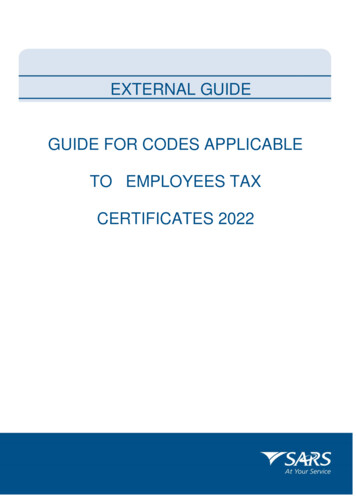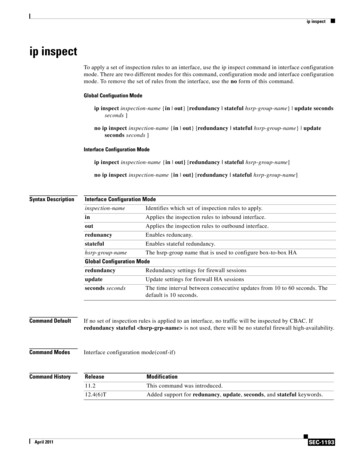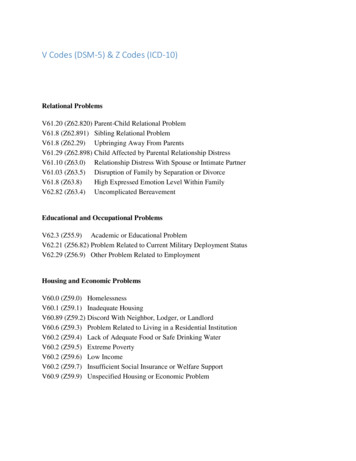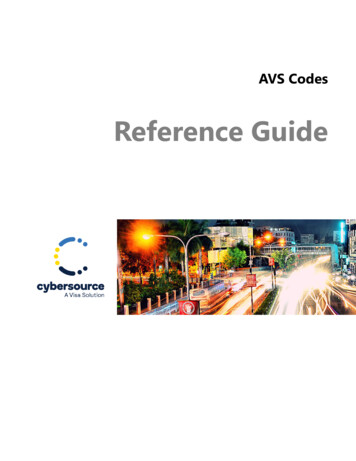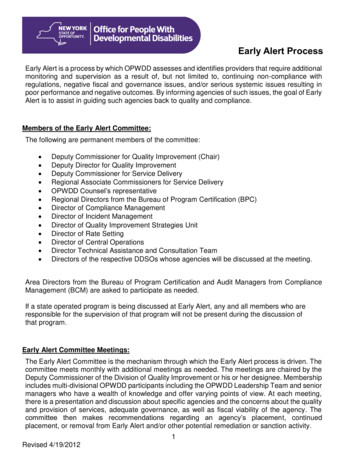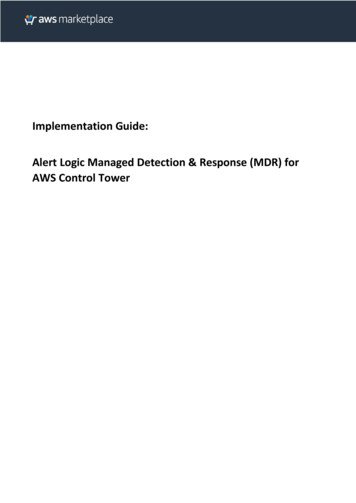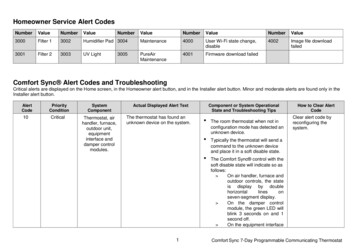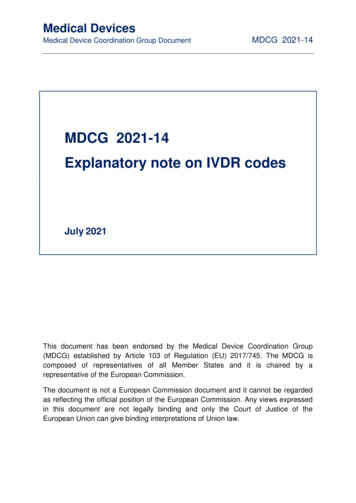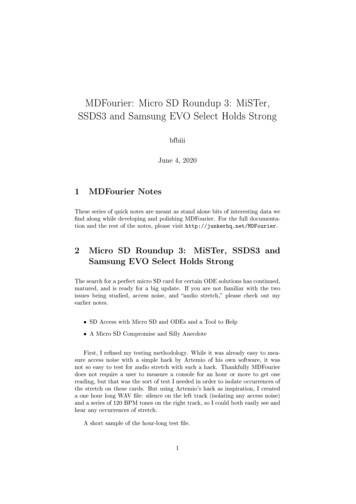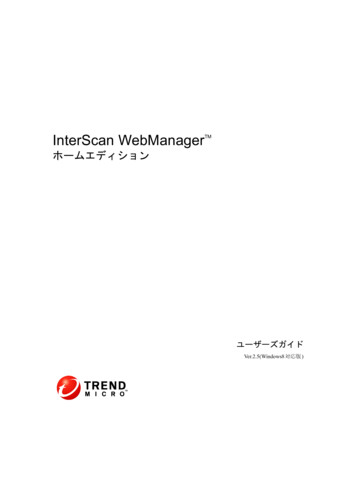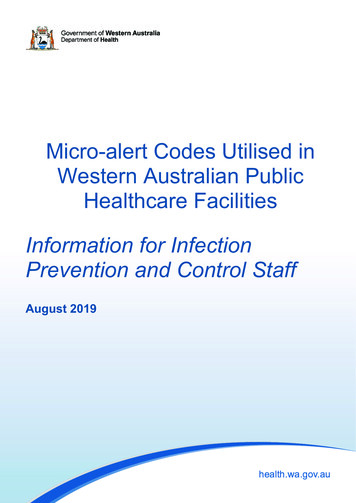
Transcription
Micro-alert Codes Utilised inWestern Australian PublicHealthcare FacilitiesInformation for InfectionPrevention and Control StaffAugust 2019
Version 2, August 2019Healthcare Associated Infection Unit (HAIU), Communicable Disease Control Directorate,Public Health Division, Department of Health, Western Australia.Reviewed by Micro-alert Governance GroupContentsIntroduction2Governance21.Access to micro-alert function32.Description33.Micro-alert codes44.5.3.1 Global codes43.2 Restricted code - Micro-alert Y43.3 Available codes5Reasons for micro-alert use54.1 Infection prevention and control54.2 Clinical flag5Notification of MROs65.1 MRSA typing results66.Identification of MRO contacts77.Activation and clearance of micro-alerts77.1 Activation77.2 Inactive status and clearance77.3 Deletions78.Informing patients of their MRO and micro-alert status89.References9Appendix 1 Micro-alert codes and definitions10Appendix 2 Abbreviations121
IntroductionMulti-resistant organisms (MROs) are microorganisms, including bacteria and fungi thathave developed resistance to multiple classes of antimicrobials. They pose a seriousthreat to public health worldwide. In healthcare facilities (HCF), MROs are associated withincreased morbidity and mortality in vulnerable patients who may acquire a healthcareassociated infection (HAIs) with an MRO that will have limited treatment options. MROscan spread readily in HCFs due to the exposure of a high-density, high-acuity patientpopulation to extensive antimicrobial use, frequent contact with healthcare workers (HCW)and contamination of the environment 1.Patients may be infected or colonised i.e. have asymptomatic carriage with an MRO andboth are a potential source of transmission to other patients. If the MRO status of a patientis known prior to, or during a hospital admission, there are measures that can be taken byHCWs to prevent transmission, reduce the risk of an infection developing in that patient.The assignment of micro-alerts on the patient administration system in Western Australian(WA) HCFs commenced in 1981 to enable the MRO status of persons, or their contacts, tobe known to relevant HCWs during their admission and therefore ensure appropriateinfection prevention strategies were implemented. In recent years the use of the microalert as a clinical flag, to ensure appropriate antimicrobial prescribing when required, hasbeen promoted. The current PAS used in public HCFs is a Web-based PatientAdministration System known as WebPAS.MROs of relevance for micro-alerting are: Candida auris (C. auris), carbapenem-resistantEnterobacteriaceae (CRE), methicillin-resistant Staphylococcus aureus (MRSA); multiresistant Gram-negative bacteria (MRGNB) and vancomycin-resistant enterococci (VRE).The purpose of this document is to provide information about the use of micro-alerts forinfection prevention and control (IP&C) staff.At no time shall a patient’s micro-alert status interfere with the admission, transfer orprovision of healthcare in any WA HCF.Governance The Western Australian Multi-resistant Organism (WAMRO) Expert Advisory Group(EAG) provides advice on the state-wide response to MROs. This group also identifiesthe MROs that require a micro-alert and endorses over-arching policy and guidelinesfor the management of these MROs. Factors considered by WAMRO in deciding which MROs require a micro-alert includethose that are associated with a demonstrated increase in transmissibility within andbetween HCFs; increased virulence and/or adverse outcomes, specific antimicrobialresistance profiles, and the emergence of new MROs. The Micro-alert Governance (MAG) group is a sub-group of WAMRO that providesadvice on the administration and functionality of micro-alerts on WebPAS to ensure therequirements of WAMRO and users of the system are met. The Healthcare Associated Infection Unit (HAIU) is the administrative arm for bothWAMRO and MAG, and ensures any enhancements or request for changes to microalerts are discussed with key stakeholders prior to any changes being made toWebPAS by Health Support Services (HSS). HCFs are to report issues with the administration of micro-alerts, or requests forenhancements, to the HAIU hiswa@health.wa.gov.au.2
1. Access to micro-alert function Personnel are required to apply for personal access to WebPAS by completing anAccess Request System form (eHFN-030). WebPAS coordinators are appointed for each Health Service Provider (HSP) and theyimplement a ‘no train no access’ policy. Training is available by PAS technical supportteams and on-line packages. Types of access are : view only access: the micro-alert status of patients can be viewed but unable toadd or clear micro-alerts full access: able to add and clear micro-alerts.Full access to WebPAS for micro-alerts is restricted to IP&C teams and designatedmedical scientists / laboratory staff.Administrative staff do not add or clear micro-alerts unless there are exceptionalcircumstances and only under the direction of IP&C staff, clinical microbiologists and/or infectious diseases physicians.2. Description Micro-alerts are accessed and viewed through WebPAS. This patient administrationsystem is a database that contains the names, unique medical record numbers(UMRN) and admission/discharge information of patients presenting at public HCFs. Micro-alerts are assigned on WebPAS by the electronic tagging of the patient’s UMRNwith a MRO specific code for those people who have been identified as MRO-positive(infection or colonisation) and their contacts (Refer to Section 3 and Appendix 1). Private HCFs cannot access the public WebPAS but generally have their own internalmicro-alert systems. Micro-alert data stored on WebPAS includes: the micro-alert code, a descriptor and thedate the micro-alert was activated and cleared (if relevant). On WebPAS the name ofthe HCF initiating the alert will be shown. The micro-alerts placed on WebPAS can also be viewed on patient labels printed formedical records and they feed downstream into the iSOFT Clinical Manager (iCM)system allowing all HCWs providing clinical care to view the micro-alert code of apatient on iCM at any time. The code can be viewed on both the home and summarypages (refer to Figures 1 and 2. NB: fictitious data used).Figure 1 iCM patient home pageMicro-alert code can be seen in the headerNote: if a patient has a medical alert, the micro-alert code(s) may not be visible in theheader and will read Micro-alert exists. The code and activation date can be viewed on the‘summary page’.3
Figure 2 iCM patient summary pageClick on Summary on the home pageMicro-alert code, descriptor and activation date3. Micro-alert codes The micro-alert codes and management of MROs are described in the WA Departmentof Health MRO policies (Refer to Table 1). MRO specific codes and the descriptor on WebPAS are summarised in Appendix 1.3.1 Global codes Global micro-alert codes are defined as codes that are viewed on WebPAS in all WApublic HCFs. All positive carriers with MRSA, VRE, CRE and C.auris and their contacts are assigneda global micro-alert (Refer to Appendix 1). WebPAS is programmed to automatically remove the following codes one year afterthe date of activation:ooW (MRSA contact)F (VRE contact)Note: micro-alert H (CRE contact) is excluded from the automatic removal system andwill remain on the WebPAS until clearance criteria are fulfilled as per policy. Automaticclearance of micro-alert H is currently under review and may be added to theautomatic removal system in the future.3.2 Restricted code - Micro-alert Y Micro-alert Y has been a restricted code for MRGNB (non-CRE) since 2012. It is onlyassigned at King Edward Memorial Hospital (KEMH), Perth Children’s Hospital (PCH)and Fiona Stanley Hospital (FSH) where neonates in high-level intensive care units areat higher-risk of a MRGNB bloodstream infection (BSI) (Refer to section 3.2). Mothersof neonates identified with MRGNB (non-CRE) are also assigned an alert due to theirclose contact with neonates. Micro-alert Y code placed at KEMH, PCH and FSH are broadcast and viewed globallyon WebPAS and iCM due to the design of these systems. It is not possible to suppressthis micro-alert Y at other HCFs. A patient with a micro-alert Y may present at otherHCFs and therefore it is important that an explanation and information on managementof MRGNB and micro-alert Y is provided in individual HCF IP&C policy.4
3.3 Available codes These are global codes that can be activated in response to a threat from newemerging MROs. There are eleven codes (A, D, E, L, M, N, P, Q, R, S, T,) that are available for use.Activation of new codes will only be implemented via the HAIU following endorsementby WAMRO.4. Reasons for micro-alert use4.1 Infection prevention and controlThe assignment of a micro-alert on WebPAS allows for early identification of patients withalerted MROs and implementation of appropriate IP&C management and patientplacement to minimise transmission within HCFs. Management is outlined in WADepartment of Health MRO policies (Table 1). Micro-alerts should be assigned as soon aspossible, once the MRO is confirmed.Table 1 MRO policyMRORelevant state policyVersionC. aurisMandatory Policy under developmentNACREInfection Prevention and Control of Carbapenem-resistantEnterobacteriaceae (CRE) in WA HCFsOD 0399/12MRSAInfection Prevention and Control of Methicillin- resistantStaphylococcus aureus (MRSA) in WA HCFsOD 0478/13No state policy. Risk-assessment based management isMRGNB recommended and outlined in individual HCF policy.VREInfection Prevention and Control of Vancomycin-resistantEnterococci in WA HCFsNAOD 0646/16These policies can be accessed from the WA Department of Health Policy Frameworkspage and found within the Public Health Framework.4.2 Clinical flag The MRSA policy (Table 1) requires that micro-alerts are used and promoted as aclinical flag in hospitals to guide medical management and ensure appropriateantimicrobial prescribing. There is evidence in the published literature that patients who are colonised with MRSAare at an increased risk for developing MRSA HAIs. Knowledge of the colonisationstatus can be important for implementation of prevention strategies, such as, empiricalantibiotic treatment of sepsis, surgical antibiotic prophylaxis, MRSA suppression ordecolonisation treatment to reduce the bacterial load -especially for higher-riskprocedures and patient populations e.g. cardiothoracic, orthopaedic (jointreplacements), haemodialysis and intensive care units 2,3,4. A micro-alert for MRGNB aids the selection of empirical antibiotic treatment of infectionin specific paediatric patient populations who are at a higher-risk for developing a BSI,e.g. pre-term neonates requiring care in higher-level neonatal intensive care units 5. There is no evidence to recommend the global micro-alerting of adult patientpopulations who are MRGNB-positive and studies have found that this practice canadversely impact antimicrobial stewardship 6. Studies have identified low transmission5
rates of ESBL-producing Enterobacteriaceae (in particular Escherichia coli) whenmanaged by standard precautions and a risk-assessment approach in acute hospitalsettings outside of outbreak situations 7.5. Notification of MROs It is essential that IP&C staff liaise with their laboratory service provider to ensure theyreceive notification of all positive C. auris, CRE, MRSA, MRGNB and VRE isolatesfrom specimens obtained at their HCF, including outpatient and emergencydepartments. In WA, CRE, MRSA and VRE (colonisation and infection) are notifiable conditions, vialaboratory notification, under the Public Health Act 2016. Public and private referringlaboratories send MRSA and VRE isolates to the PathWest Gram-positive ReferenceLaboratory and CRE isolates to the PathWest Gram-negative Reference Laboratory forconfirmation and further characterisation and molecular typing. In WA, C. auris is currently not a notifiable disease, however, due to the significance ofthis organism, all laboratory detections of C. auris are to be notified to the HAIU usingthe email HISWA@health.wa.gov.au HCFs that assign micro-alerts based on antibiotic susceptibility when the initial resultsare reported, i.e. prior to receiving the final typing results, need to review confirmatorytyping results and modify the micro-alert on WebPAS if required.5.1 MRSA typing results New MRSA cases are entered on WebPAS as a micro-alert B or C according to thefollowing classifications reported by the PathWest Gram-positive Reference laboratory:o micro-alert B PVL negative (strain not identified)o micro-alert B PVL positive (strain identified)o micro-alert C (strain identified). The laboratory distributes the MRSA typing results (refer to Figure 3) to the referringlaboratory, and also to the generic IP&C e-mail address, at the relevant HCF. It isessential that IP&C personnel ensure their e-mail address is maintained. The majorityof reports are sent within four days of the MRSA isolate being received by PathWest.Figure 3 Sample MRSA HCF report from typing laboratory In 2013 the assignment of a micro-alert for PVL-positive clones, with the exception ofUSA300 and Bengal Bay, changed from a micro-alert C to B. When patients affectedby this change present to a HCF, the alerts can be changed following a review by IP&Cpersonnel i.e. the micro-alert C can be cleared and the patient assigned a micro-alert Bif no other specimens have identified a micro-alert C strain. When assigning the microalert B, the initial activation date or the date of the most recent micro-alert B isolate isto be used.6
6. Identification of MRO contacts Identifying MRO contacts for screening and/or micro-alerting requires tracking thelocation of MRO-positive patients during an admission and identifying patients thathave shared a room, bathroom or toilet with them as per definitions in the relevantMRO policy (Refer to Table 1 and Appendix 1). The use of WebPAS for electronic contact tracing is recommended due to the potentialfor multiple internal transfers of patients during an admission. WebPAS coordinatorscan provide further information.7. Activation and clearance of micro-alerts7.1 Activation Prior to activating an alert, it is essential that IP&C personnel ensure that the isolate isa laboratory-confirmed MRO of relevance for micro-alerting. The micro-alert code is assigned on WebPAS by personnel at the HCF where thespecimen was identified, including from emergency and outpatient departments.PathWest provide support for adding C, G, H, J, and V alerts for MROs identified in theprivate sector. The date of collection of the first specimen that resulted in a positive MRO result(infection or colonisation) is to be recorded as the date activated.7.2 Inactive status and clearance There are no criteria for use of an inactive status in the MRSA, VRE or CRE policiesand there is no requirement for a micro-alert to be made inactive before a clearancedate is entered. The inactive field is not to be used. Patients can be cleared of a micro-alert only when clearance criteria outlined in therelevant MRO policy is met. This applies to MRSA or VRE positive patients andcontacts and CRE and C. auris contacts. There is no clearance policy for CRE or C.auris positive patients. The date of clearance is to be entered in the End Date (date cleared) field on theUpdate page in WebPAS. This will result in the micro-alert code being removed fromglobal view on WebPAS and ICM. IP&C staff can still view the history and date cleared on the Update page inWebPAS on WebPAS the date the micro-alert is cleared will show in the Inactive/Exp Enddate field on the micro-alert home page clearance history is not shown on iCM. Private hospitals who have obtained screening swabs for MRSA and VRE clearance orC. auris and CRE contact clearance can send copies of the results tohiswa@health.wa.gov.au.For VRE clearance refer to the VRE Clearance Protocol and Form athttp://ww2.health.wa.gov.au/Articles/S T/Tools-and-Resources7.3 Deletions A micro-alert is not to be deleted unless it is entered in error e.g. wrong patient or thefinal laboratory results confirm the isolate is not a significant MRO that requires amicro-alert.7
8. Informing patients of their MRO and micro-alert status Transparent management of personal information and open communication betweenthe health service provider and health consumer are important for balancing the dualgoals of providing the flow of information to HCWs who need to know and steps tomeet patient privacy requirements.State MRO policies require that a person who is identified as MRO-positive and microalerted at a HCF is to receive written notification of their MRO status and provided withan information sheet on the MRO isolated.When a MRO contact is identified and discharged prior to notification and completion ofscreening it is recommended that hospitals provide written information in a letter.8
9. References1. NHMRC 2019, Australian Guidelines for the Prevention and Control of Infection inHealthcare. Accessed 14 August 2019 at -content-block-12. Kepler A, Stewart J, Crouch H, Florez C, Hospenthal D. Methicillin-resistantStaphylococcus aureus (MRSA) nares colonisation at hospital admission and its effect onsubsequent MRSA infection. CID 2004 (39):776-82.3. Sadfar N, Bradley E. The risk of infection after nasal colonisation with Staphylococcusaureus. AJM 2008. vol 121;4:310-315.4. Keene A, Vavagiakis P, Mei-Ho Lee M, Finnerty K, Nicolls D, et al. Staphylococcusaureus colonization and the risk of infection in critically ill patients. ICHE 2005; 26(7):622628.5. Giuffre M, Geraci D, Bonura C, Saporito L, Grazian G, Insinga V, Aleo A, Vecchio D,Mammina C. The increasing challenge of multidrug-resistant Gram-negative bacilli.Results of a 5 year active surveillance program in a neonatal intensive care unit. Medicine2016: 95 (10):1-9.6. Rottier W, Bamberg Y, Dorego-Zetsma J, Van der Linden P, Amerlaan H et al.Predictive value of prior colonization and antibiotic use for third-generation cephalosporinresistant Enterobacteriaceae bacteraemia in patients with sepsis. CID 2015:60 (11):162230.7. Tschudin-Sutter S, Frei R, Dangel M, Stranden A, Widner A. Rate of transmission ofextended-spectrum beta-lactamase-producing Enterobacteriacea without contact isolation,CID 2012:55(11):1505-11.9
Appendix 1 Micro-alert codes and definitionsMRO and micro-alertcodeDefinitionCandida aurismicro-alert JLaboratory confirmed C.aurismicro-alert K - contactAny person who has shared a patient room, bathroom or toilet facility witha known positive C. auris patient (infection or colonisation) within theperiod 28 days prior to first isolation of C. auris and for whom screeninghas not been completed prior to discharge.Carbapenemase-resistant Enterobacteriaceaemicro-alert Gmicro-alert H - contactLaboratory confirmed CRE with confirmed presence of a carbapenemaseproducing enzyme, including but not limited to, KPC, NDM, VIM, OXA andIMP.KPC: Klebsiella pneumoniae carbapenemase; NDM: New Delhi metallo-βlactamase; VIM: Verona integron-encoded metallo-β-lactamase; OXA:Oxacillinases; IMP: Imipenemase.Any person who has shared a patient room, bathroom or toilet facility witha CRE positive patient prior to implementation of contact precautions andfor whom screening has not been completed prior to discharge.Methicillin-resistant Staphylococcus aureusLaboratory confirmed MRSA and MRSA clones with increased antimicrobial resistance and/or virulence factors, and have not demonstratedhigh transmissibility in hospitals.micro-alert B PVL negative clonesWA community MRSA clones (not typed)micro-alert Bmicro-alert B PVL positive clones - Nomenclature (MLST-SCCmec)includes:Qld clone (ST93-IV)Western Samoan (WSPP) (ST30-IV)Taiwan CA-MRSA (ST59/952-VT)European CA-MRSA (ST80/583/728-IV)WA-121 (ST-5-IV)WA-62 (ST-923-IV)Laboratory confirmed MRSA and MRSA clones with increased antimicrobial resistance and/or virulence factors and/or demonstrated hightransmissibility in hospitals, as determined by the WAMRO ExpertAdvisory Group.micro-alert Cmicro-alert W - contactMicro-alert C clones - Nomenclature (MLST-SCCmec) includes:EMRSA-15,16 (ST22-IV,ST36-II)Aus-2/3 (ST-239-III)New York/Japan (ST5-II)Irish-2 (ST8-VI)USA300 (ST8-IV) (PVL positive)Bengal Bay (ST772-V) (PVL-positive)Any person who has shared a patient room with a micro-alert C positivepatient prior to the patient having contact precautions initiated and forwhom screening has not been undertaken or completed prior todischarge.10
Vancomycin-resistant enterococcimicro-alert Vmicro-alert F - contactLaboratory confirmed vancomycin resistant Enterococcus faecalis andEnterococcus faecium (vanA and vanB).Any patient who has shared a patient room, bathroom or toilet facility witha VRE positive patient prior to implementation of contact precautions andfor whom screening has not been completed prior to discharge.11
Appendix 2 AbbreviationsBSIBloodstream infectionC.aurisCandida aurisCDCDCommunicable Disease Control DirectorateCRECarbapenem-resistant EnterobacteriaceaeESBLExtended spectrum beta-lactamaseFSHFiona Stanley HospitalHAIHealthcare-associated infectionHAIUHealthcare Associated Infection UnitHCFHealthcare facilityHCWHealthcare workerHICWAHealthcare Infection Council of Western Australia (Executive group)HISWAHealthcare Infection Surveillance Western AustraliaHSPHealth Service ProviderHSSHealth Support ServicesiCMiSOFT Clinical ManagerIP&CInfection prevention & controlKEMHKing Edward Memorial HospitalMAGMicro-alert Governance (Group)MRGNBMulti-resistant Gram-negative BacteriaMRSAMethicillin-resistant Staphylococcus aureusPASPatient Administration System(s)PCHPerth Children’s HospitalPVLPanton-valentine leukocidinVREVancomycin-resistant enterococciWAWestern AustraliaWAMROWA Multi-Resistant Organism (Expert Advisory Group)WebPASWeb-based Patient Administration System12
This document can be made available in alternative formatson request for a person with disability. Department of Health 2019Copyright to this material is vested in the State of Western Australia unless otherwise indicated. Apartfrom any fair dealing for the purposes of private study, research, criticism or review, as permitted underthe provisions of the Copyright Act 1968, no part may be reproduced or re-used for any purposeswhatsoever without written permission of the State of Western Australia.
Note: if a patient has a medical alert, the micro-alert code(s) may not be visible in the header and will read . Micro-alert exists. The code and activation date can be viewed on the 'summary page'. -alert code can be seen in the header . 4 . Figure 2 iCM patient summary page. 3. Micro-alert codes
